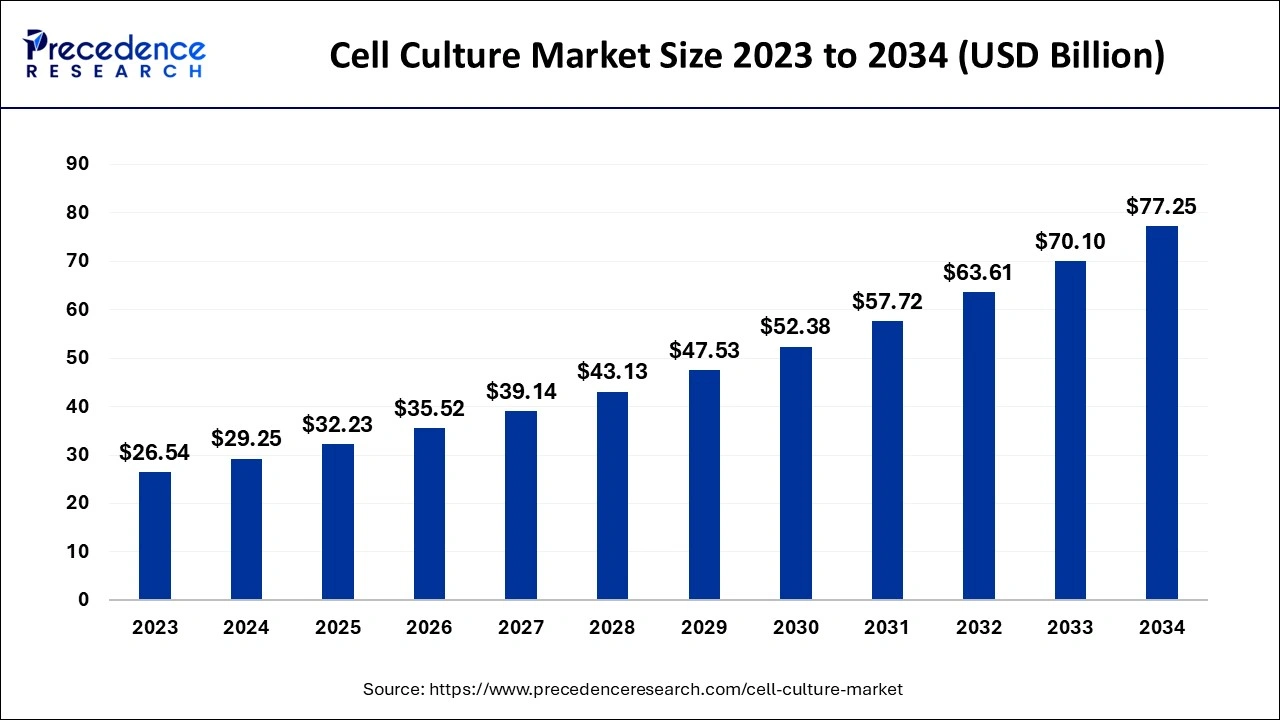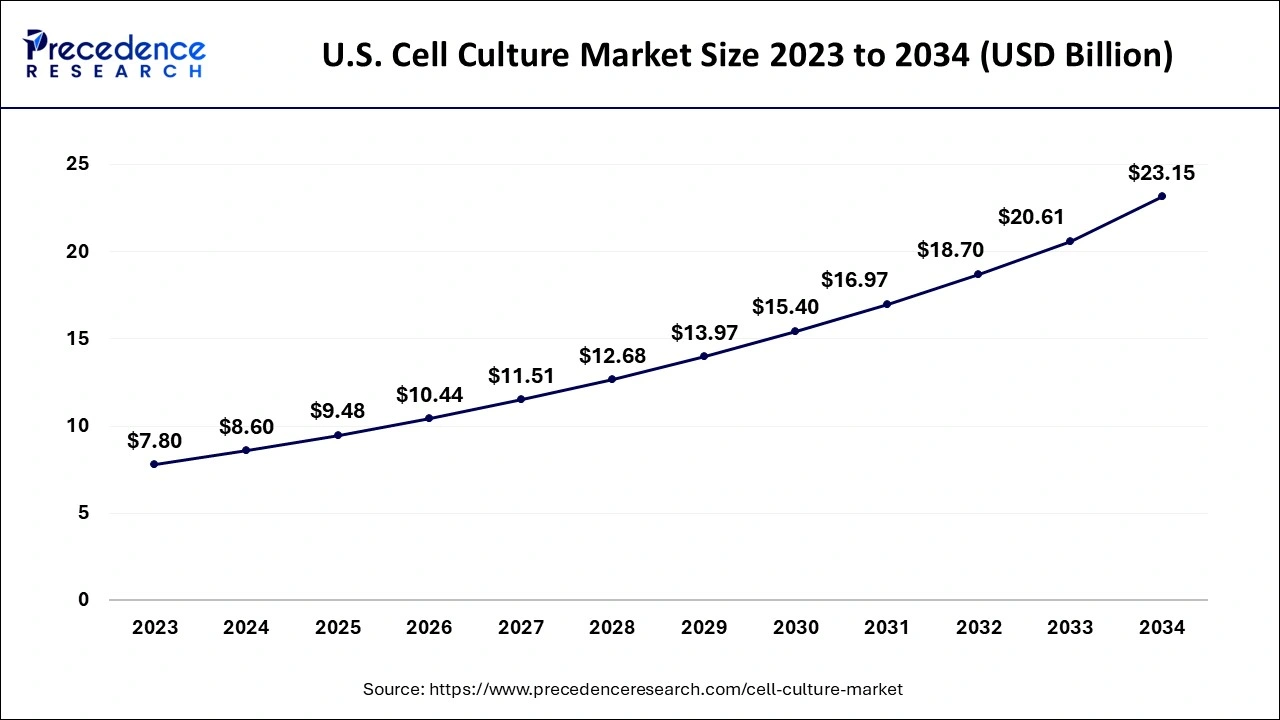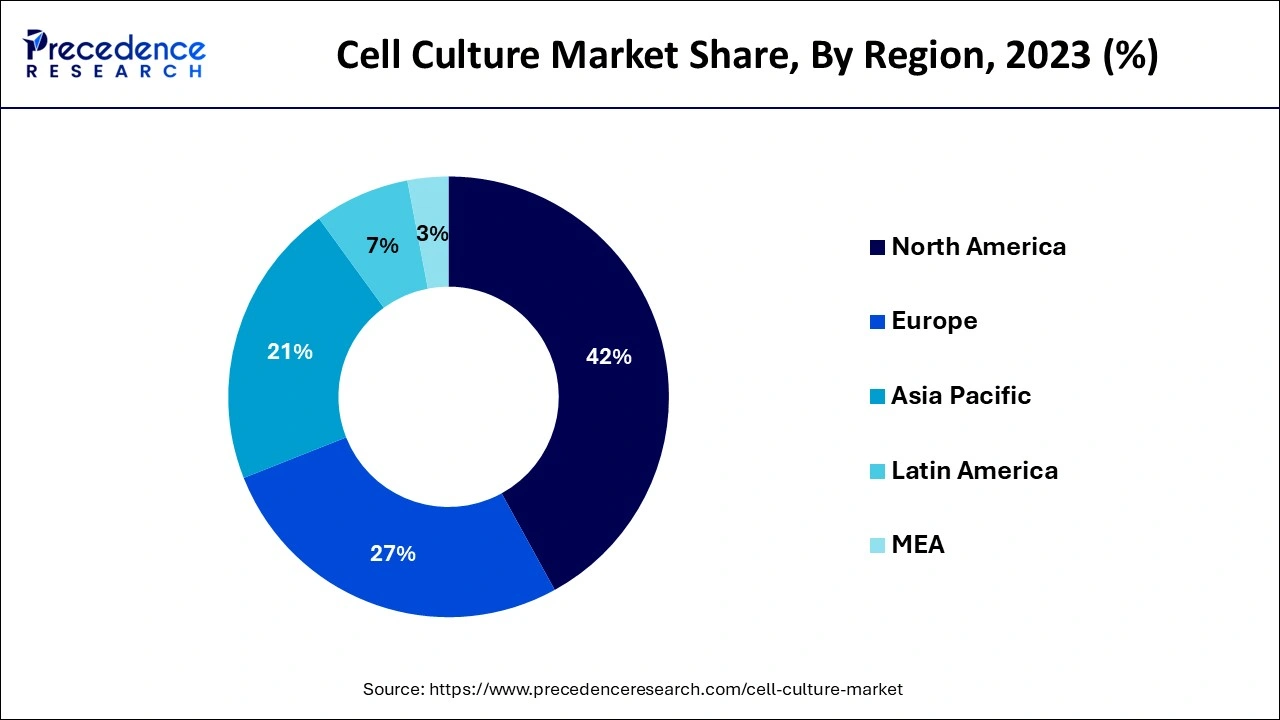List of Contents
What is the Cell Culture Market Size?
The global cell culture market size is estimated at USD 29.25 billion in 2024 and is anticipated to reach around USD 77.25 billion by 2034, expanding at a CAGR of 10.20% from 2024 to 2034.

Cell Culture Market Key Takeaways
- By consumable, the media segment has market share of around 51% in 2023.
- By product, the culture systems segment has accounted for 26% of the market share in 2023.
- By application, the biopharmaceuticals segment has captured highest makret share of around 27% in 2023.
- By region, the North America has contributed market share of around 42% in 2023.
AI in the Market
The artificial intelligence (AI) sector is changing the cell culture market and the technology at the same time. One way AI has a major part in the cell culture market is through the automation of cell processes with precision. AI systems take advantage of real-time data from imaging tools and sensors to create the best environmental conditions for cells, thus improving their health and reproducibility, but with less human intervention. This results in better standardization, less variability, and faster drug discovery timelines. Besides, machine learning models forecast optimal media compositions as well as bioprocesses with the help of fine-tuning the output to achieve better yields and products with the desired quality attributes. In such advanced applications as 3D cell culture and cell therapy, AI supports the consistent organoid production and correct cell potency assessment. All in all, the AI incorporation raises the cell culture procedures' efficiency and dependability, which in turn allows the manufacturing of safe and effective biologics and therapeutics at a lower cost, with less human error.
U.S. Cell Culture Market Size and Growth 2024 to 2034
The U.S. cell culture market size is evaluated at USD 8.60 billion in 2024 and is predicted to be worth around USD 23.15 billion by 2034, rising at a CAGR of 10.40% from 2024 to 2034.

Based on region, North America dominated the global cell culture market in 2023. The recent outbreak of the COVID-19 pandemic in 2020 has significantly boosted the cell culture market in North America. The rising investments towards the research studies on the mechanisms underlying COVID-19 diseases are fueling the growth of the cell culture market. Moreover, the surging demand for the personalized medicine in US and the presence of several leading market players in the region has significantly contributed towards the growth of the North America cell culture market. The favorable supportive policies of the Federal government in terms of medical research as the healthcare is one of the significant industries in US has led to the rapid growth of the cell culture market in North America. In 2016, The Human Cancer Models Initiative was undertaken that aimed at growing 1,000 new cell line for scientific studies within a period of three years. The presence of leading biopharmaceutical companies along with the numerous contract research and contract manufacturing organizations has resulted in the rapid growth of the North America cell culture market.

Asia Pacific is expected to witness the highest CAGR during the forecast period. The rising penetration of the top biopharmaceutical companies and the presence of several top contract research organizations in countries like India, China, South Korea, and Japan are significantly contributing towards the growth of the Asia Pacific cell culture market. The rising number of drug discovery activities and rising demand for the cell culture techniques among the research laboratories and academic research institutions is expected to have a significant and positive impact on the growth of the Asia Pacific cell culture market in the forthcoming years.
Cell Culture Market Growth Factors
The process of cell culture includes growth of cells beneath controlled conditions, usually out of their regular environment. Interested cells are then separated from livelihood tissue. They are being able to sustain beneath the controlled condition consequently. The global cell culture market is expected to grow at a significant rate during the forecast period owing to the rising awareness regarding the benefits of cell based vaccines, rising prevalence of chronic diseases, surging demand for monoclonal antibodies, rising funds for cell based research, rising adoption of single-use technologies, shifting focus towards personalized medicine, and the introduction of advanced cell culture products. The development of novel 3D cell culture techniques and surging demand for these techniques in biopharmaceutical industry for the development of vaccines and biopharmaceutical drugs is expected to drive the growth of the global cell culture market.
Rising technological advancements in the proteomic gene expression and the development of novel biopharmaceuticals and vaccines is fostering the demand for the 3D cell culture technologies across the globe. The rising prevalence of cancer and growing number of cancer research projects and improved applications of gene therapies is driving the growth of the global cell culture market. The presence of various contract manufacturing and research firms are positively contributing towards the growth of the cell culture market. The rising incidences of chronic diseases among the global population have attracted the investments towards the cytology and biology research studies.
Moreover, the rising developments in the stem cell therapy are expected to support the growth of the cell culture market. The rapidly growing biopharmaceutical industry is boosting the demand for the cell culture techniques. The biopharmaceutical industry constitutes around 20% of pharmaceutical industry and is expected to grow rapidly in the upcoming future.
- The increasing knowledge of the benefits of cell-based vaccines and advanced therapeutic solutions is the main reason for the market to expand.
- Chronic diseases and cancer are among the major causes of the increasing investment in cell-based research and gene therapy.
- The development of 3D cell culture is making biopharmaceutical research and personalized medicine even more effective.
- The shift towards single-use technologies and automation in labs is creating a situation where cell culture operations are easily scalable and efficient.
- The booming biopharmaceutical and stem cell research industries are the main cause of the need for new and innovative cell culture systems and media formulations.
Market Scope
| Report Coverage | Details |
| Market Size by 2024 | USD 29.25 Billion |
| Market Size by 2034 | USD 77.25 Billion |
| Growth Rate from 2024 to 2034 | CAGR of 10.20% |
| Largest Market | North America |
| Base Year | 2023 |
| Forecast Period | 2024 to 2034 |
| Segments Covered | Type, Application, End User, Distribution Channels, Geography |
Burgeoning Need of 3D Cell Culture
The methods of 3D cell culture are earning traction upon 2D methods of cell culture owing to numerous factors. The growth of cells is done on the flat surfaces as single layers of 2D. Nevertheless, these cells stick to vessels as well as connect to cells in the direction of the boundary. This restricts complex cell cultures. To solve this problem, scientists have pop up with a solution of 3D cell cultures. This solution has been effective in various studies of fundamental biologic mechanisms like viability, morphology, number monitoring, and proliferation.
Further, these cell cultures have a longer lifespans and higher stability in comparison with 2D cultures. Various market players have invested in these cell cultures owing to its advantages. For instance, Lonza announced the collaboration with CELLINK to provide solution for 3D bio printing prepared to develop whole 3D cell culture methods in the year 2020. Corning Incorporated expanded its cell culture portfolio by adding two 3D products which contains matrix and microplate in the year 2019.
In addition, market players have increased their concentration over the products like microfluidic organ-on-a-chip illustrations. These chips are designed to imitate organ physiology. The growth of 3D cells happens inside the cubicle of microchip in the scaffolds. Key market players are investing in different startups to speed up the sales and marketing of these 3D cell culture products. For instance, the U.S. based startup Kiyatec Inc. announced that it has received funding of $3 million to advance 3D cell culture for the detection of cancer in individuals in the month of May, 2019. InSphero is an inventive supplier of platforms which are based on 3D cell for efficiency testing as well as for the discovery of drugs. These kind of efforts from the investors and the prominent market players are anticipated to provide lucrative opportunities for the global cell culture market over the next decade.
Product Insights
Based on the product, the global cell culture market was dominated by the consumables segment. The rise in the funding for the cell based studies has significantly fostered the consumption of consumables. The rapidly growing number of biopharmaceutical companies, contract manufacturers, contract research organizations, and academic research institutes is a major factor behind the increased demand for the consumables across the globe. The growing prevalence of diseases, rising focus on personalized medicine, and growing number of research studies are expected to boost the growth of consumables segment during the forecast period.
On the other hand, the equipment is expected to be the fastest-growing segment during the forecast period. The rising technological advancements and high profit margins associated with the various cell culture equipment are boosting the growth of this segment. The rising demand for the equipment among the cell culture application development companies and the research laboratories is fueling the market growth significantly. The introduction of automation and robotics is expected to enhance the performances and boost the market growth in the forthcoming future.
Application Insights
Based on application, the biopharmaceuticals segment dominated the global cell culture market in 2023. The extensive usage of the mammalian cell cultures in the development of mammalian pharmaceuticals has led to the dominance of the biopharmaceuticals segment. Moreover, the bio-production of genetically and proteomically enhanced medicines has led to the increased demand for the non-conventional drugs across the globe. The rising popularity of the biopharmaceuticals among the patients owing to its increased efficiency in treatment of various diseases has significantly boosted the growth of this segment. The rising research and developmental activities in the biopharmaceuticals is boosting the demand for the cell culture techniques. The rising demand for the cell culture techniques among the contract researchers and contract manufacturers owing to the increased adoption of these third party services among the biopharmaceutical companies is a prominent factor behind the dominance of the biopharmaceuticals segment in the global cell culture market.
Drug discovery is anticipated to be the most opportunistic segment during the forecast period. The demand for the latest and innovative drugs owing to the rising prevalence of various chronic and gene related diseases among the population is boosting the demand for the cell based research studies for the development of novel therapies and vaccines. Cell culture is known to be an integral part of the research and drug discovery process. Previously, 2D culture was adopted but with the introduction of 3D culture techniques, the global cell culture industry has witnessed an evolution. The 3D cell culture has made the cell based high throughput screening more accurate and easier. The rising investments by the biopharmaceutical companies in the drug discovery process to develop innovative and effective therapies and vaccines is expected to boost the growth of the drug discovery segment in the cell culture market in the upcoming future.
Increasing Demand for Cell Culture-Based Vaccines
The unprecedented rise in the cases of the COVID-19 pandemic has induced various companies operating in the biotechnology and pharmaceuticals to manufacture antiviral drugs or vaccines to fight against it. Some of them got the approval and some are under advancement and getting manufactured. Cell culture is plays a vital role in the advancement of drug, as a result boosted the demand for cell culture products.
Viral vaccines developed on the basis of cell culture are considered the most effective to boost the immunity of humans against the caused infections. SARS-COV-2 virus employs mammalian cell lines for several research and developments. Following the maintained level of pharmaceutical efficiency, nutrients and components needed to develop cells beneath the conditions of controlled environment, cell mediums come in the usage. Products of cell culture which include equipment, culture media, as well as reagents support scientists to examine cellular behavior, which is going to aid the advancement of vaccines.
Research and development of vaccines require cell culture technologies, which are anticipated to boost its usage in the coming time. The Indian Council of Scientific and Industrial Research (CSIR) based Center for Cellular and Molecular Biology (CCMB) has found the constant cultures of the virus SARS-CoV-2 out of the samples of patients. The effective usages of this have been determined for manufacturing vaccines, checking of antibodies, screening of drugs, and other activities.
The process of cell culture is the constant one of advancing layers for safe manufacturing of the products like viral vaccines. Despite all this, safety rules are being stricter for the manufacturing of vaccines to stop the spread of this deadly virus, thus enforcing producers and scientists to manufacture viral vaccines with the help of cell culture products. This factor considerably augmented the demand for cell culture products, in return helped grow the revenue growth trajectory especially during the years 2020 and 2022.
Cell Culture Market Companies
- Corning Incorporated
- Merck KGaA
- Sartorius AG
- BioSpherix, Ltd.
- Cell Culture Company, LLC
- Thermo Fisher Scientific Inc.
- VWR International LLC
- Lonza
- Eppendorf AG
- FUJIFILM Irvine Scientific, Inc.
Key Market Developments
- In October 2019, Thermo Fisher Scientific introduced the first cell culture media that remain stable at room temperature.
- In October 2021, Thermo Fischer Scientific introduced its Gibco Cell Therapy Systems (CTS) NK-Xpander Medium that facilitates the growth and culture of functional natural killer cells at large scale.
- In September 2021, Cytiva expanded its production capacity by launching 3 manufacturing facilities in just 10 months for bio-processing single use consumables.
Value Chain Analysis
- R&D: The main goal is to find new medications and improve the cell culture methods for the biopharmaceutical industry to come up with innovative products.
Key Players: Thermo Fisher Scientific, Merck KGaA. Danaher Corporation - Clinical Trials and Regulatory Approvals: They're responsible for making sure the product is safe, effective, and meets the requirements of the health authorities all over the globe.
Key Players: Central Drugs Standard Control Organization (CDSCO), Indian Council of Medical Research (ICMR), Contract Research Organizations (CROs) such as Fortrea - Formulation and Final Dosage Preparation: The process that turns the cultured cells into stable, usable formats that are fit for medical use.
Key Players: Thermo Fisher Scientific (Gibco), Sigma-Aldrich (owned by Merck), ATCC - Packaging and Serialization: It is the process of securing the products and making the entire supply chain visible by assigning a unique identifier to each product.
Key Players: Wipotec, CCL Healthcare, CCL Label - Distribution to Hospitals and Pharmacies: It's the process of controlling the safe movement of products based on cell technology to the medical sector.
Key Players: Cold-chain couriers, Third-party logistics (3PL) providers, Pharmaceutical wholesalers/distributors - Patient Support and Services: Their role is to carry out post-market surveillance, provide technical support, and conduct patient education to ensure favorable results.
Key Players: ProPharma, UBC, Claritas Rx
Segments Covered in the Report
By Product
- Equipment
- Centrifuges
- Culture Systems/Bioreactors
- Biosafety Equipment
- Cryostorage Equipment
- Pipetting Instruments
- Incubators
- Cell Culture Vessels
- Others
- Consumables
- Reagents
- Growth Factors & Cytokines
- Albumin
- Protease inhibitor
- Thrombin
- Attachment Factors
- Amino Acids
- Sera
- Fetal Bovine Serum (FBS)
- Others
- Media
- Chemically Defined
- Classical Media
- Lysogeny Broth
- Serum Free
- Protein Free
- Specialty Media
By Application
- Drug Discovery
- Biopharmaceuticals
- Monoclonal antibodies
- Vaccines production
- Other therapeutic proteins
- Tissue Culture and Engineering
- Cell and gene therapy
- Other tissue engineering & regenerative medicine applications
- Vaccine Production
- Gene Therapy
- Others
By End User
- Pharmaceutical & Biotechnology Companies
- Hospitals & Diagnostic Laboratories
- Research & Academic Institutes
- Other
By Geography
- North America
- U.S.
- Canada
- Europe
- U.K.
- Germany
- France
- Asia-Pacific
- China
- India
- Japan
- South Korea
- Malaysia
- Philippines
- Latin America
- Brazil
- Rest of Latin America
- Middle East & Africa (MEA)
- GCC
- North Africa
- South Africa
- Rest of the Middle East & Africa
For inquiries regarding discounts, bulk purchases, or customization requests, please contact us at sales@precedenceresearch.com
Frequently Asked Questions
Ask For Sample
No cookie-cutter, only authentic analysis – take the 1st step to become a Precedence Research client